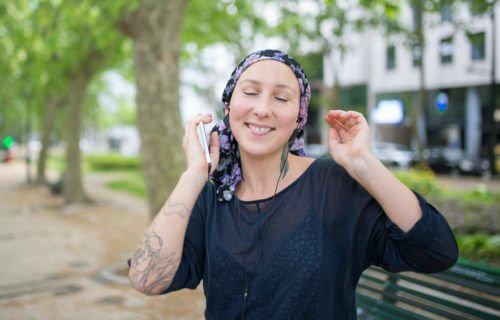CLEVELAND — The right song at the right time can make the perfect memory, but new findings from a team at University Hospitals Cleveland Medical Center suggest music can also be medicine for many. Scientists have found patients with cancer or sickle cell disease (SCD) receiving treatment at an academic cancer center reported feeling significantly less pain and anxiety after undergoing music therapy.
Notably, SCD patients participating in music therapy felt much more pain and anxiety at baseline in comparison to patients with hematologic and/or oncologic conditions excluding SCD.
These findings come from a retrospective study conducted between January 2017 and July 2020. During that period, music therapists at UH Connor Whole Health provided 4,002 music therapy sessions to 1,152 patients, encompassing 2,400 encounters at UH Seidman Cancer Center. This was the largest investigation of the real-world effectiveness of music therapy within hematology and oncology ever conducted to date. This work also builds on an entire history of seminal music therapy studies funded by the Kulas Foundation that have investigated the efficacy of music therapy across palliative care, surgery, and sickle cell disease at UH.
“The music therapy programming provided at Seidman Cancer Center offers a unique and effective means of symptom management for patients and family members throughout their cancer journey. In particular, music therapy services are fully integrated throughout both inpatient and outpatient units to provide continuity of care through transitional periods of treatment.” says Seneca Block, The Lauren Rich-Fine Endowed Director of Expressive Therapies at UH Connor Whole Health, in a media release.
What does music therapy include?
UH Connor Whole Health boasts the largest health system-based music therapy program in the United States. Board-certified music therapists collaborate with providers to help lessen the physical and emotional toll of an illness or hospitalization on patients and their families. Moreover, UH Connor Whole Health provides a diverse additional array of integrative health and medicine modalities, including acupuncture, chiropractic, and integrative medicine consults. All of these approaches emphasize patients’ entire well-being.
In this latest project, researchers examined the clinical delivery and effectiveness of music therapy at UH Seidman Cancer Center. On a more detailed level, researchers compared the effectiveness of music therapy on pain, anxiety, and fatigue among adult patients with SCD to that same music therapy’s influence on adult patients with hematologic and/or oncologic conditions excluding SCD (the HemOnc group).
Interventions provided by music therapists included live music listening, active music making, and songwriting to address patients’ needs including coping, pain management, anxiety reduction, and self-expression. The music therapists also analyzed patients’ self-reported pain, anxiety, and fatigue using a 0-to-10 scale at both the beginning and end of each session. Study authors documented the sessions in each person’s electronic health record.
“What makes this research unique is our ability to collect all our data within the electronic health record and then extract and analyze it to understand the real-world impact of music therapy,” explains first study author Sam Rodgers-Melnick, a music therapist and a co-investigator on the EMMPIRE project (Effectiveness of Medical Music Therapy Practice: Integrative Research using the Electronic Health Record) examining the effectiveness of music therapy throughout the UH Health System. “This research highlights the increased symptom burden that adults with SCD face in the hospital and the significant impact that a single session of music therapy can have on their pain and anxiety.”
What do patients say about the treatment?
Rodgers-Melnick also served as the principal investigator for the first systematic research project focusing on the use of music therapy for individuals with SCD and has led various related studies funded by the Kulas Foundation since 2014. Those earlier studies support the notion that music therapy is good for managing acute pain, improving self-efficacy and quality of life, and improving sickle cell disease knowledge among adolescents and young adults making the transition from pediatric to adult care.
This newest research shows that, among the combined sample of patients in the SCD and HemOnc groups, there were statistically significant reductions in pain (1.48 units), anxiety (2.58 units), and fatigue (0.84 units). Importantly, fluctuations in pain and anxiety exceeded clinically significant thresholds. Music therapy sessions differed between the two groups, however, with activities like active music making, songwriting, and song recording being much more prevalent among the SCD group than the HemOnc group. Also, many patients said they were pleased with the music therapy, expressing themes including enjoyment, gratitude, and improvements in mood, pain, and anxiety.
“It helps me release the everyday pressure and stress that is going on,” comments one patient featured in the study’s qualitative analysis. “I’ve had a lot of hard times, but this really gives me courage. You gave me a way to articulate my feelings.”
Patient testimonials highlight the importance of music therapists in addressing patients’ needs.
“Our work goes beyond providing tailored receptive music interventions to address symptoms. The ways in which we build therapeutic relationships with patients and actively engage them in the musical process are essential for helping patients to express their thoughts and feelings and cope with extended series of treatments at the cancer center,” Rodgers-Melnick states.
“Integrative Oncology utilizes complementary therapies, such as music therapy discussed in this study, to improve well-being for those affected by cancer. Using an evidence-based approach and building off research allows us to confidently build a program around supporting patients with integrative modalities as part of a strategy to manage symptoms that they may encounter through therapies or from cancer,” explains Santosh Rao, MD, a board-certified medical oncologist and integrative medicine provider and Medical Director of Integrative Oncology at UH Connor Whole Health.
The study is published in the journal Integrative Cancer Therapies.

